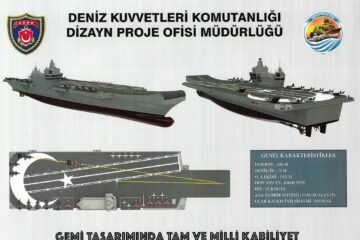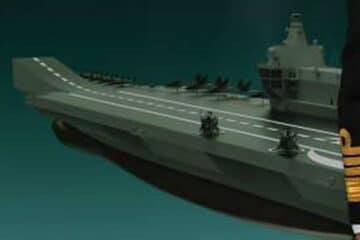The newest Chinese aircraft carrier has started with “dead load” launch testing for her electromagnetic catapult system, as was confirmed by footage circulating on Chinese and Western social media. On November 26 Chinese military-enthusiasts shared footage first on Chinese social media platform Weibo and subsequently also on “X”, formerly Twitter, recorded from an airplane overflying the extensive shipyard facilities where CNS 18 Fujian, also known as the Type 003 aircraft carrier, is currently berthed. Since the Pudong Shanghai International Airport is located very closely to Changxing Island, the location of builder Jiangnan and other shipyards, related imagery taken from passenger planes has become a common source to follow the progress of several major PLAN-programs.

The video footage shows launch and subsequent drop of a test vehicle from the port side third catapult position on the new aircraft carrier, into the water of the basin in front of Fujian. A large barge used to move hull components had previously relocated from its mooring position also in front of Fujian, ostensibly to make way for this part the testing regime. Similar efforts, termed “dead load”-testing, are common for all catapult-equipped aircraft carriers, including after major overhauls, such as most recently on French Navy-carrier “Charles de Gaulle” in Toulon.

Catapult-testing important step towards sea trial
Overflight and satellite imagery shared on social media on November 19th and over the following days had previously shown Fujian moving away from her berth. The development prompted expectations over a sea trial, although this seemed unlikely at the time, given no preparations to crew and equip the carrier for such a step were visible on the Fujian over the preceding weeks. In fact at least some construction and integration work appears to still be ongoing notably around the island.

Given the new imagery now the event was likely related to the Chinese aircraft carrier having started catapult testing. This notion is supported also by spotting of several large orange objects likely to represent the dead load-test vehicles. Over the next few days the carrier then returned to her normal berth location. Fujian moving away a short distance and then returning to the mooring position may have been required in the context of testing her starboard third catapult launch position on the angled flight deck, although this remains speculative.

Timeframe for more testing uncertain, but sea trial still expected soon
Among enthusiast circles a first sea trial is still expected in the near future, perhaps within a few months, although it is important to consider that Fujian represents a groundbreaking effort with many firsts for builder Jiangnan and operator PLAN. As such timelines may extend considerably beyond optimistic expectations, and past schedules for existing carriers CNS Liaoning (16) and Shandong (17), both lacking catapults, are unlikely to reflect the testing and integration regime for Fujian.

The newest American aircraft carrier, Gerald Ford (CVN-78), which possesses a broadly similar electromagnetic catapult launch and recovery system compared with Fujian, had undertaken her first dead load-testing with builder Newport News in the James River in June 2015, a few months after initial shipborne no-load-testing, and almost two years before she would get underway on her own power for the first sea trial. The American system is dubbed EMALS for electromagnetic aircraft launch system, and the term is also used sometimes to describe the Chinese catapult, although both are different developments, with the Chinese version reportedly featuring some notable technical differences. As such the testing regime on CVN-78 may only serve as a very broad reference for timeframes, given the multiple problems encountered on this new design, which PLAN may not face in a similar fashion on Fujian.
About Aircraft Carrier Fujian

CNS Fujian (18), the overall third aircraft carrier for the Chinese Navy, had commenced construction some time before 2018, when the first large modules were spotted at builder Jiangnan in Shanghai. The ship was launched from drydock, where most of the assembly took place, in June 2022. Since then fitting out-work had proceeded in a basin to which Fujian had moved after her launch. The supercarrier, displacing over 80,000 tons at a length of approximately 316 metres, is the first catapult-equipped aircraft carrier (CATOBAR) for PLAN, but expected to be followed by multiple future hulls with a similar arrangement over the next decade. Fujian is expected to undergo trials and testing over the next year and may be commissioned with PLAN in 2025.
Update 30/11: An earlier version of this article stated that the dead load vehicle was launched from a forward catapult position. Reviewing more recent higher quality imagery in fact suggests the test was conducted from the port side catapult position on the angled flight deck. The article has been revised to reflect that information.






